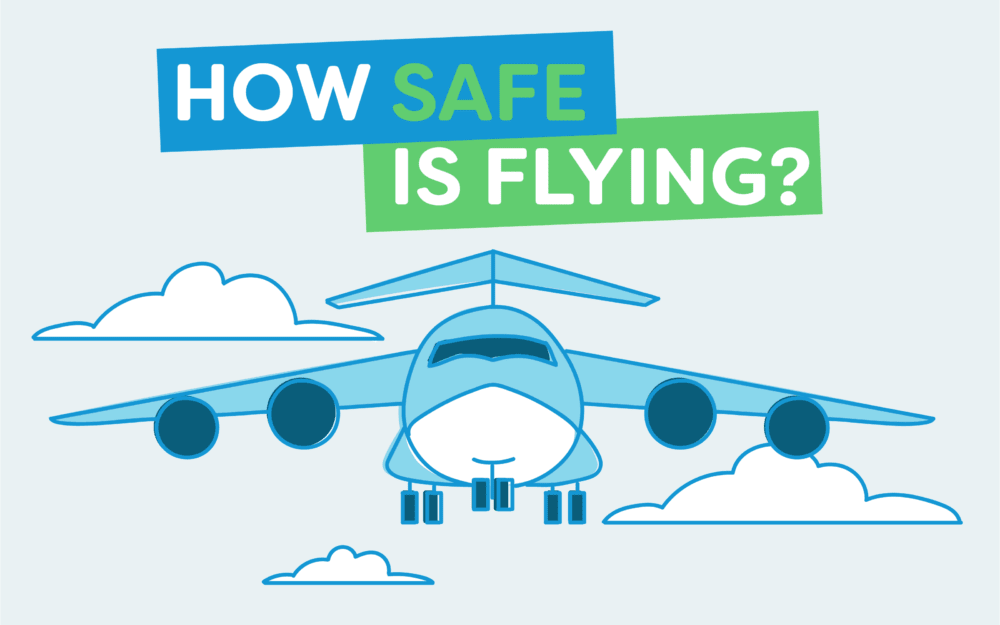How safe is flying in 2025?
Flying is extremely safe, with the risk of a fatal crash at just 1 in 11 million, according to Harvard research. Compared to other forms of transport, air travel is the safest, with a 95.7% survival rate in accidents. The risk of any accident is also low—just 1 in 830,000 flights in 2022, and enhanced safety protocols make flying safer every year.
How safe is flying in 2024? If pre-flight jitters have you wondering how safe it is to hop a plane, these aircraft safety facts and statistics will ease your mind. I’d know — I’m a licensed pilot, so I consider myself an expert on flying and the air transport system as a whole.
So, is air travel safe? Yes! And to ease your mind before hopping on a plane, I’ve rounded up some key safety data that’ll put the wind back in your sails and boost your confidence in both pilots and the airlines.
How Safe Is Flying?
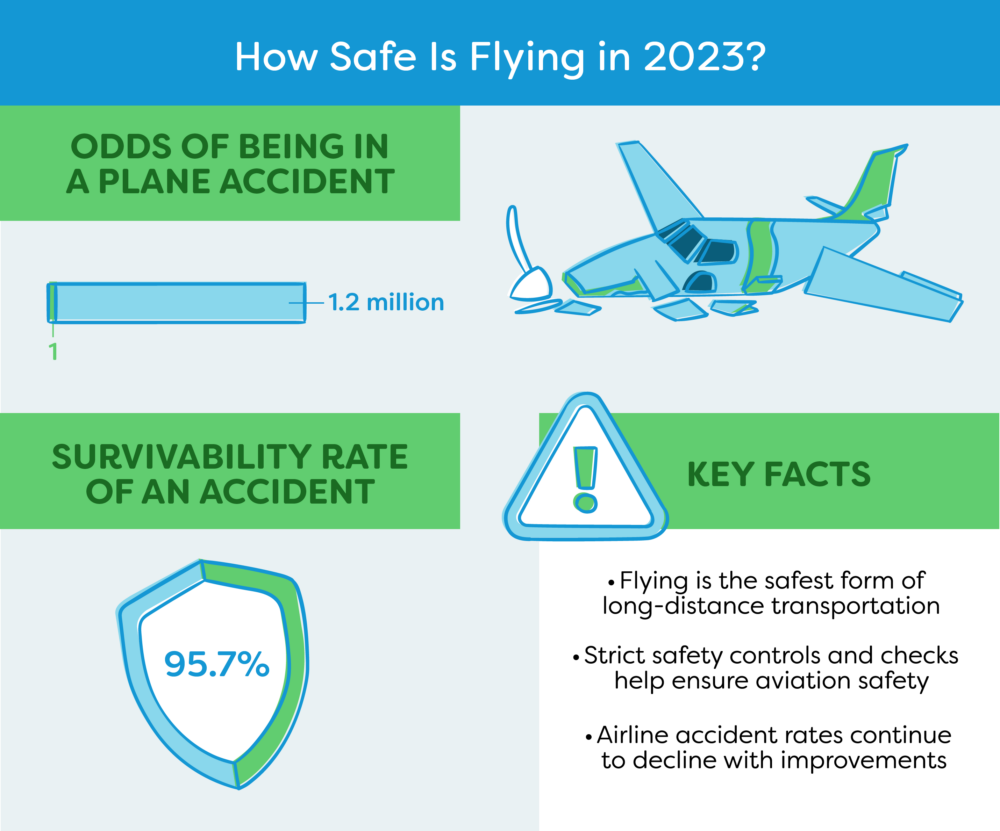
According to ICAO (the International Civil Aviation Organization), aviation is the first ultra-safe transportation system in history.
This means that for every ten million cycles (a cycle is both a takeoff and landing), there’s less than one catastrophic failure. Flying is still the safest way to travel long-distance, as aircraft accidents and fatalities are less common than car, truck, motorcycle, train, and bus accidents.
If that’s not enough to convince you, just look at the data: according to Harvard researchers, your chances of being involved in a fatal plane crash are incredibly small – around 1 in 11 million.
While your odds of being in a plane accident are about 1 in 1.2 million, survivability rates are about 95.7% – so the odds are with you no matter how you look at it.
A few key facts:
- Flying is the safest form of long-distance transportation
- Strict safety controls and checks help ensure aviation safety
- Airline accident rates continue to decline with improvements
For many, the idea of boarding a plane is synonymous with anxiety and fear. But is fear of flying completely justified or unfounded? We know that airplane accidents happen, but most airplane alarmists admit they don’t know the actual risk level of flying.
So how safe is flying in general, with more than 126,000 take-offs and landings around the world every single day? How much risk are you really taking when you choose to fly?
We consulted recent and long-term aviation safety and accident studies to find out how safe flying really is. And as it turns out, flying is actually one of the safest forms of transportation.
In fact, flying is the safest way to travel long distances, according to the Bureau of Transportation Statistics – safer than traveling by car, motorcycle, bus, or train.
Fewer accidents occur on commercial and commuter planes – what most of us fly in when traveling – than any of these modes of transportation.
Private planes are an exception, with more fatalities per year than commercial and commuter planes, trains, and buses. Still, even private planes are safer forms of transportation than cars, motorcycles, and trucks.
Combing through the data, it’s clear that continually-improved aviation safety rules and checks are responsible for making flight one of the safest ways to travel with accident rates steadily declining over the years.
We’ll cover recent flight safety statistics, airline accidents and their most common causes, aircraft fatality numbers, and safety data trends over the years to see how flight safety is improving.
How Common Are Plane Crashes?
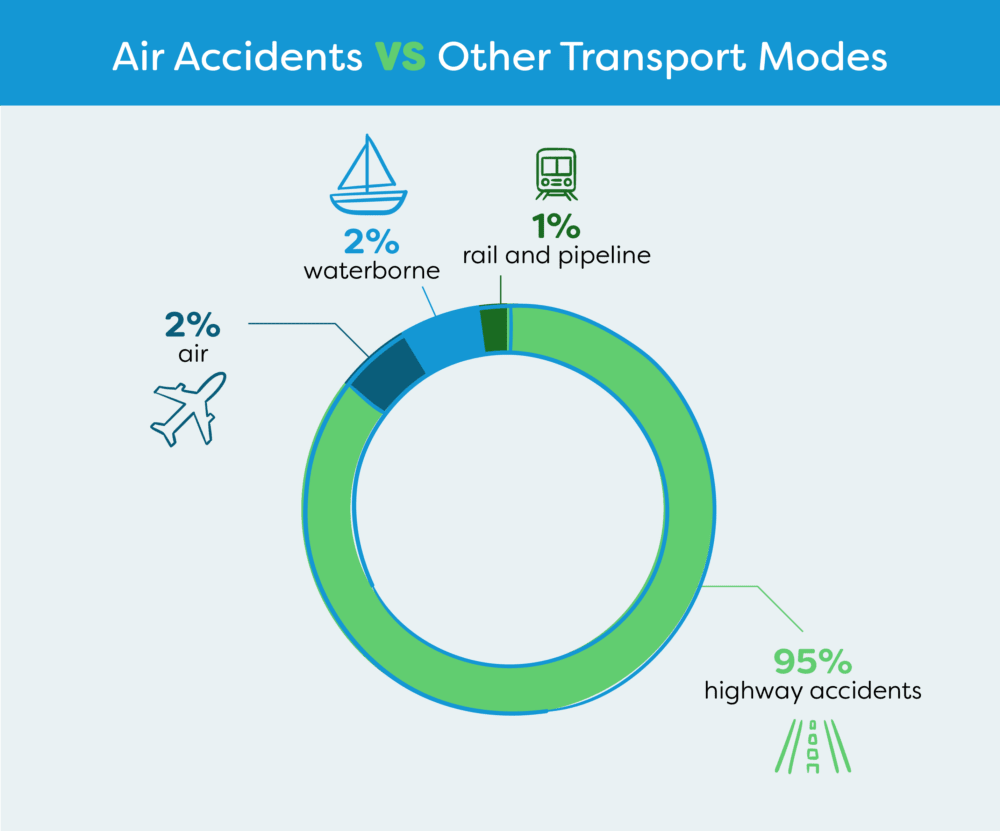
When you board a plane, your risk is never absolutely zero – an indisputable fact that troubles many people with a fear of flying.
But it’s important to know the actual risk level of a plane crash or accident so you can make fact-based decisions when you consider future flights.
We talked about the overall safety level of flying in a commercial or commuter plane compared to driving or riding in a car, motorcycle, truck, train, or bus.
The data unequivocally shows you’re much more at risk on the highway than you are in the air.
Here’s a look at how the safety level stacks up when comparing highway, air, waterway, and rail transportation modes in 2011, according to the Bureau of Transportation Statistics.
Statistics don’t lie, and the numbers indicate that more people die every year in accidents involving cars, light trucks, motorcycles, heavy trucks, buses, and trains than planes every year.
Your risk level isn’t zero, however, and that’s where we want to focus. Knowing your actual risk level might help ease your flight concerns.
Risk of Fatal Aircraft Accidents
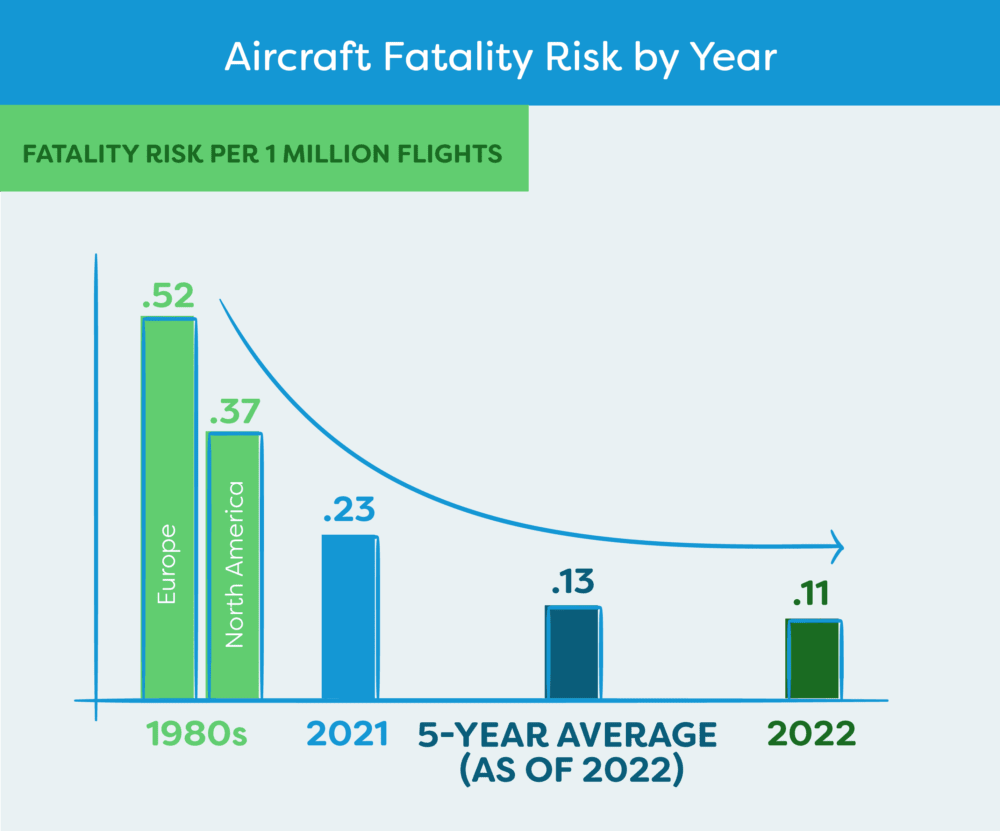
Fatal airplane accidents are the ones that keep you up at night with worry. It’s also the reason you probably searched for “is plane travel safe?” But don’t worry — it’s normal.
When these rare events do occur, they dominate the news and firmly plant themselves in our thoughts. No wonder it’s a common concern for air travelers!
But aircraft fatality risk is on the decline, down to 0.11 in 2022 from 2021’s risk of 0.23. The 5-year running average fatality risk is 0.13, according to data from the International Air Transport Association (IATA).
This shows a marked improvement over the 1980s flight fatality risk range of 0.37 to 0.52 in North America and Europe.
In 2017, the safest year for air travel so far, there were zero fatalities on commercial airlines – an incredible testament to the level of rigorous pilot, mechanic, and air traffic controller training and enhanced safety measures in place.
In 2021, the second-safest year for air travel, there was only 1 fatal accident involving a large commercial aircraft (though 125 lives were tragically lost in the crash).
Note that COVID-19 restrictions and lockdowns reduced the total number of flights, which probably skews the statistics for 2020-2021.
There was a lower-than-average number of total fatal crashes (12) in 2022, but higher number of air travel fatalities (229 total). Sadly, 132 of those deaths occurred in a single fatal China Eastern Airlines flight crash on March 21st.
It’s worth noting that since 2009, only 2 people have died in commercial plane crashes in the United States. From this data, we can conclude that your overall risk of being involved in a fatal aircraft accident is very, very low.
Risk of Any Aircraft Accidents
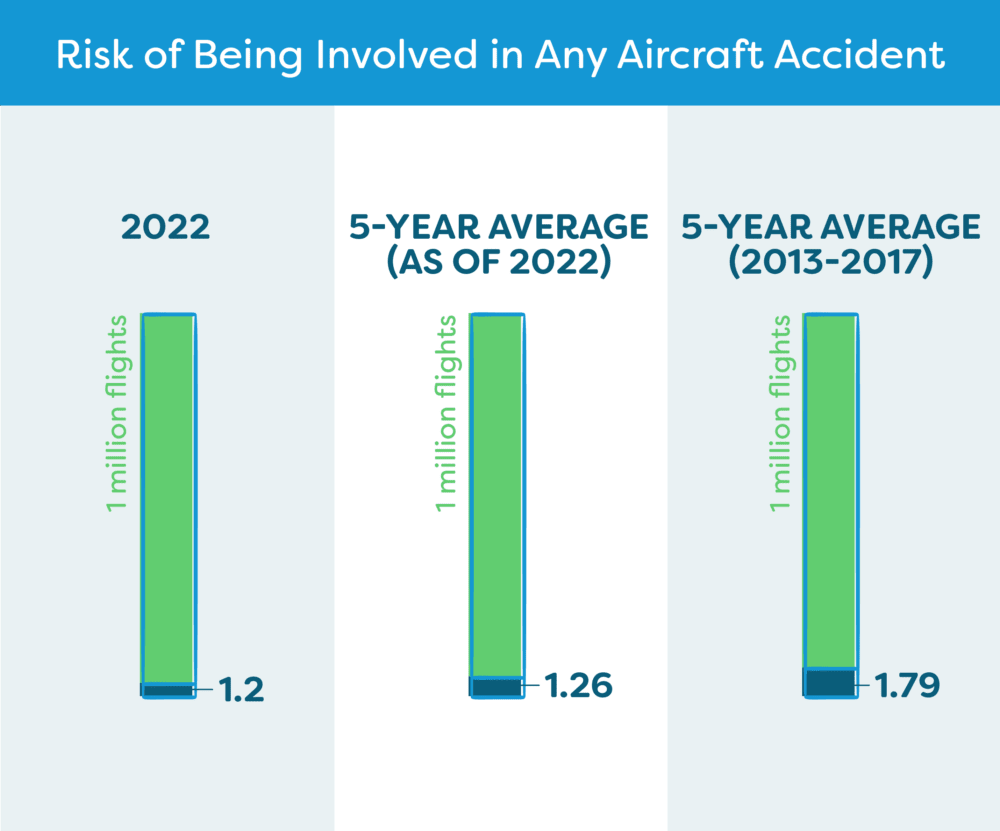
Fatal accidents are the root concern for most, but any kind of aircraft accident can be a worrisome possibility. So what’s the chance of being involved in any kind of accident in the air?
For that data, we look to the all accident rate in recent years from the IATA. In 2022, the average risk was 1 accident per 0.83 million (830,000) flights.
That’s a reduction from the average all accident risk of 1.26, or 1 accident for every 810,000 flights) over the last 5 years (2018-2022).
It’s a major improvement from the previous 5-year period from 2013-2017, when the all accident rate stood at 1.79, according to the IATA.
Your risk of being in any kind of aircraft accident is very low, but it is slightly higher than your risk of being in a fatal aircraft accident.
The 4 Most Common Flight Risk Factors
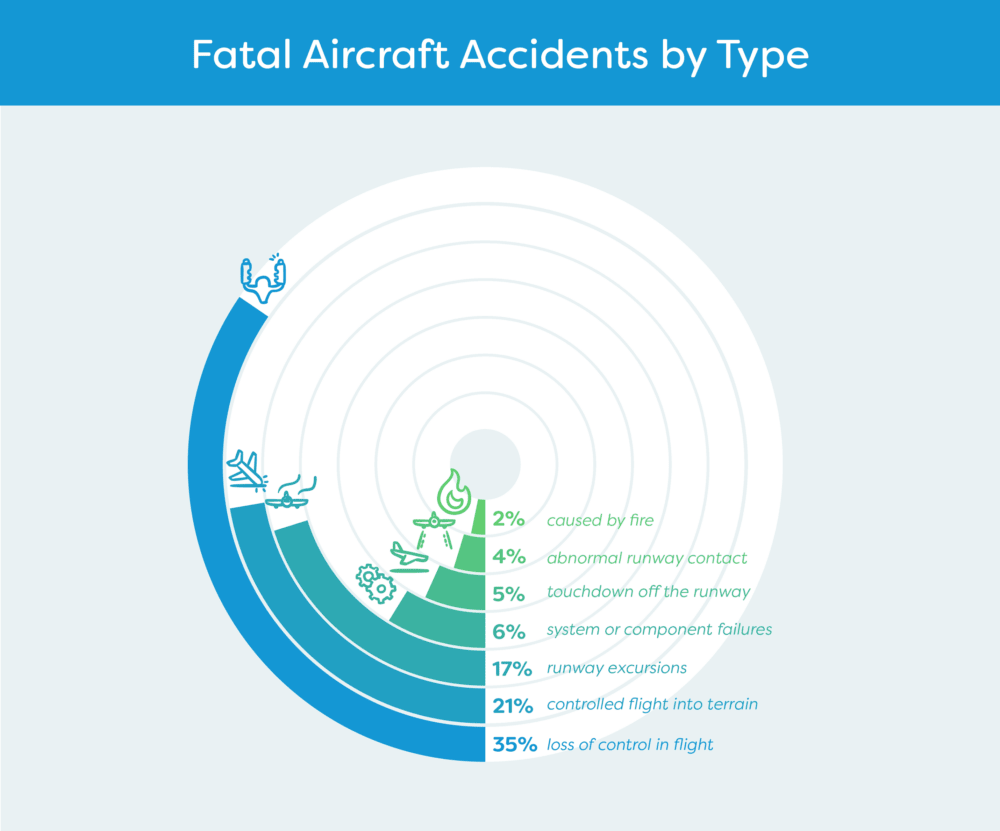
When plane crashes and accidents do happen, what’s the cause? Looking at the risk factors and root causes can help you get a clearer picture of how safe it is to fly.
Boeing found that about 80% of aircraft accidents are due to human error – pilots, air traffic controllers, and plane mechanics – while about 20% are caused by mechanical errors and equipment failures.
Keep in mind that these accidents are still very rare. Worldwide, we’re talking about a small number of accidents and an even smaller number of fatal crashes each year.
According to the International Civil Aviation Organization (ICAO), the most common fatal aviation accident causes are as follows:
- 35% are caused by loss of control in flight
- 21% are caused by controlled flight into terrain
- 17% are caused by runway excursions
- 6% are caused by system or component failures
- 5% are caused by touchdown off the runway
- 4% are caused by abnormal runway contact
- 2% are caused by fire
These causes can be grouped into 4 basic categories: Pilot error, mechanical error, inclement weather, and air traffic controller error.
Let’s take a look at each of the most common causes of aircraft accidents (fatal and non-fatal) and other things to know about flying to answer the question “How safe is flying?”.
Pilot Errors
Pilot errors are the leading cause of aircraft accidents. From loss of control in flight to abnormal takeoff or landing, a pilot’s error can lead to accidents when flying.
Loss of pilot control of the plane or aircraft is the most common cause of fatal accidents, according to Allianz.
Since the pilot is at the “helm,” any issue they have with executing a safe flight, navigating, responding to current air, plane, and weather conditions, and maintaining clear contact with air traffic control can lead to an accident.
This is why extensive pilot training, flight checklists, safety briefings, and risk management is so important for airline pilots.
While pilot error is the leading cause of accidents, it’s still very rare because pilot training is extensive, thorough, and ongoing. You’ll never find yourself on a commercial plane without a skilled and experienced pilot.
Mechanical Errors
Mechanical errors represent about 22% of all accidents as the second most common cause of aviation accidents.
Mechanical errors can occur for a few reasons – it could be an improperly maintained plane part, a bad part installation, or even a flaw in the plane’s design.
Bird strikes, when a bird hits a plane’s engine during flight, can also lead to mechanical errors in the air.
Since mechanical errors represent a big chunk of aviation accidents, they’re taken very seriously and maintenance checklists are stringently followed pre- and post-flight.
Inclement Weather
Inclement weather causes around 12% of aviation accidents. It’s the third most common cause of accidents in the air.
Rough, stormy weather, extreme cold and ice, and dense fog can all interfere with a pilot’s ability to properly fly a plane or directly affect the plane’s mechanical condition.
Lightning strikes are especially dangerous when flying, since they can fry the plane’s electrical systems or spark fuel tanks to ignite.
Stormy weather, high winds, turbulence, and poor visibility can all interfere with flight safety, but usually won’t cause catastrophic accidents when the pilot can change course or altitude to avoid problems.
Air Traffic Controller Errors
Air traffic controller errors are the 4th most common cause of aviation accidents.
While much less common than pilot errors, mechanical errors, and inclement weather issues, accidents caused by air traffic controllers can be fatal.
Air traffic controllers are responsible for communicating with the pilot, guiding air traffic along safe courses, and keeping proper distance between aircraft for safety.
Air traffic controllers may have a dozen aircraft on their radar at one time, keeping weather conditions, traffic, flight routes, and plane information in mind as they control the flow of aircraft.
A small mistake can be catastrophic, but thankfully, these types of accidents very rarely occur.
Air traffic controllers receive extensive training and education, and only about 1% of applicants will actually be hired on in this competitive and challenging field.
Flying Is Only Getting Safer Over Time
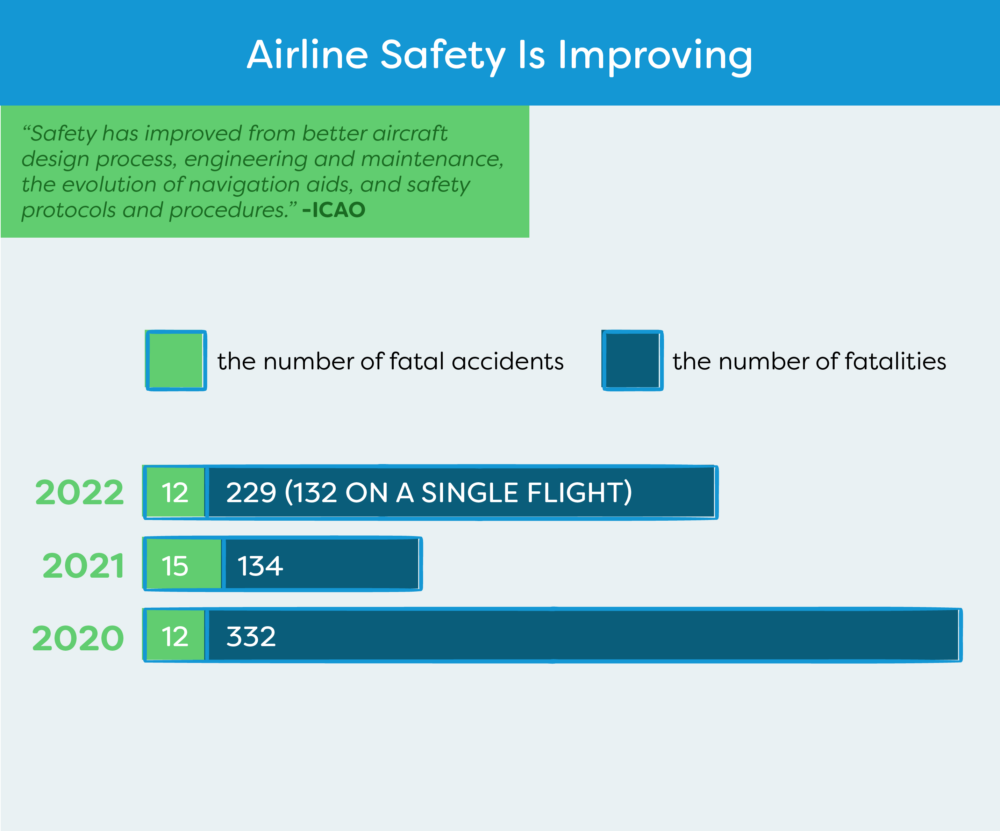
When you ask “How safe is flying?”, it’s important to consider the statistics and data not just from years past and present, but also looking ahead to the future.
Global flight accident rates (aka the overall risk of flying) have been steadily declining over the years for a number of reasons, according to the International Civil Aviation Organization (ICAO).
As ICAO notes in a safety report, “Safety has improved from better aircraft design process, engineering and maintenance, the evolution of navigation aids, and safety protocols and procedures.”
The data backs it up, too as the number of fatal accidents continues to drop in either accident numbers or fatality numbers over recent years.
In 2022, there were 12 fatal airline accidents with a total of 229 deaths globally (132 of these fatalities happened in a single China Eastern Airlines flight).
In 2021, there were 15 fatal (only 1 commercial) airline accidents with 134 fatalities and 12 accidents in 2020 with 332 fatalities.
Airlines and aviation organizations continue to adopt more rigorous reporting, training, and improved equipment to continually make flying even safer than in years past.
Innovations like artificial intelligence for maintenance, monitoring, and support, automated turbulence reports, electronic flight bags (EFBs), and Enhanced Ground Proximity Warning Systems (EGPWS) are key in making it as safe as possible to fly.
Things to Consider
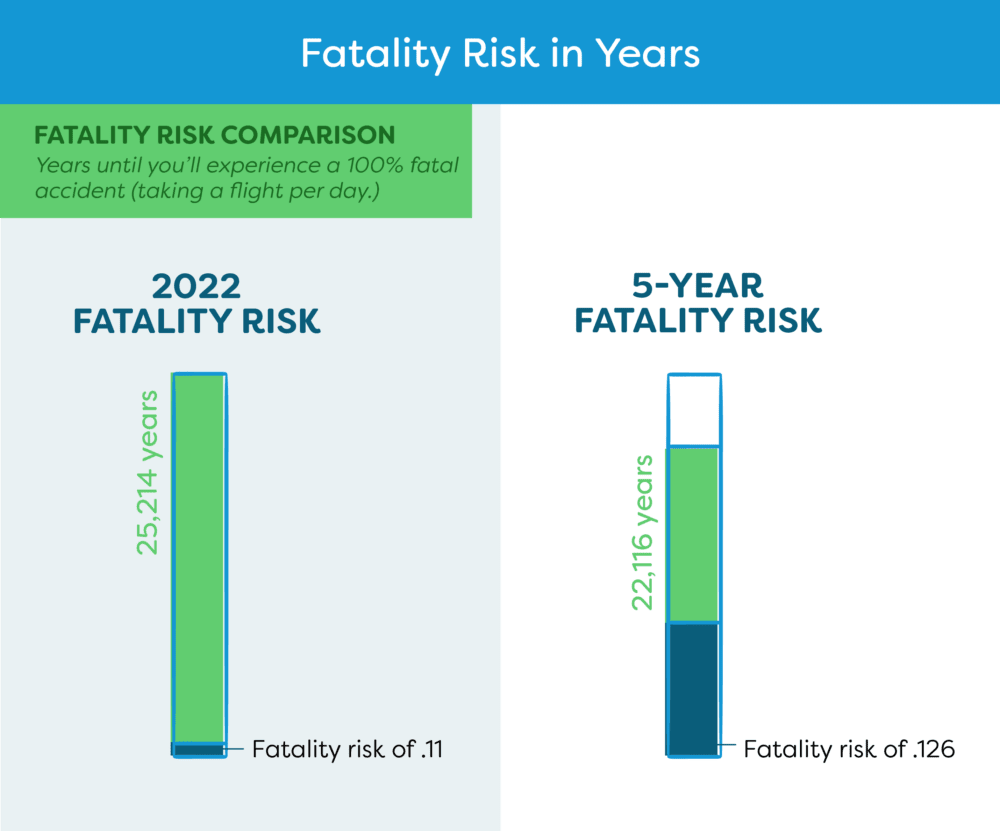
The industry 2022 fatality risk of 0.11 means that on average, a person would need to fly on an airplane for 25,214 years to experience a 100% fatal accident. This is an improvement over the five-year fatality rate (average of 22,116 years).
- The plane food puts you at more risk than the flight. Harvard University researchers found your chances of being killed in a plane crash are about 1 in 11 million, while your odds of dying of food poisoning are closer to 1 in 3 million.
- Fatal accidents are incredibly rare. Using 2022 flight safety data from IATA, you’d have to fly everyday for 25,214 years to experience a 100% fatal aircraft accident. Even if you use the 5-year data instead, you’d still have to fly everyday for 22,116 years to experience a 100% fatal accident.
- Flying often won’t increase your risk by much. While the average American flies 1-2 times per year, you won’t be at much higher risk if you fly a lot more regularly because the odds of fatalities and accidents are so low.
- Even if your plane crashes, odds are, you’ll survive. Most people involved in a plane accident or crash will survive, contrary to public perception. The National Transportation Safety Board found that 95.7% of people survive the rare aircraft accidents and crashes that do happen.
Frequently Asked Questions
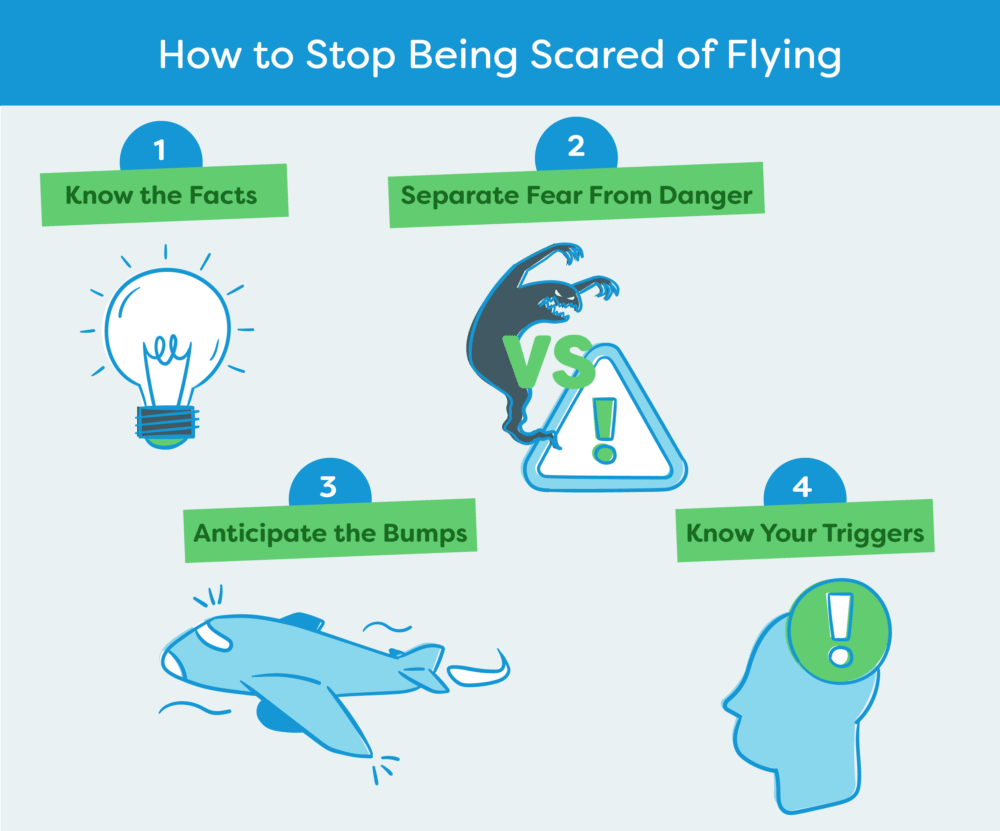
Still wondering “how safe is flying” or “is it safe to fly on a plane?” Here are some of the most frequently asked questions on the topic to help put your concerns to rest.
How do I stop being scared of flying?
Fear of flying is a deeply personal issue, but it's often helpful to learn about the facts and statistics on flight safety and risks to put your mind at ease. While your odds of being in a plane accident are about 1 in 1.2 million, survivability rates are about 95.7% - so the odds are with you no matter how you look at it.
Is flying at night or day safer?
Some data indicates that flying earlier in the day may be slightly safer, since pilots have better visibility, are most alert, and usually haven't run into any flight delays. Accident statistics from Plane and Pilot Magazine show about 10% of all aviation accidents occur at night. But accidents at night can be more likely to be fatal. Still, flying commercial during the day or night will be very safe overall due to pilot training under all lighting and weather conditions.
How is flying so safe?
Flying is considered very safe due to modern technology, improved aircraft equipment designs, and enhanced pilot, mechanic, and air traffic control training.
There are fewer planes in the air than cars and trucks on the road with much more space between them, further leading to safer travel conditions.
Oversight by air traffic control and automated systems also contribute to the safety of flying over driving or riding on other types of road and rail transportation.
Where is the safest place to sit on an airplane?
To further increase your safety and reduce your risk of injury or death when flying, sit in the middle near the back. Time Magazine found that people sitting in the middle rear seats on a plane during an accident had a 16% lower risk of death than those in the middle aisle seats.
So, Is It Safe to Fly on an Airplane?
From a look at the very low frequency of plane accidents and crashes to the most common aviation accident causes and a forward look at how air safety is improving over time, we’ve taken a long look at how safe flying is overall.
Plane accidents and crashes do happen – there’s no getting around it, just like car crashes and motorcycle accidents – but they are by far the rarest form of transportation accident that occurs.
Your odds of being in an aircraft accident or fatal crash are astonishingly low – like, 1 in 11 million low. Don’t let a fear of flying prevent you from going to amazing places while you’re here on Earth!
Flying is very safe overall, and it’s still the safest way to travel long distances. If fear of flying has been holding you back from taking a bucket list trip or seeing faraway friends and family, consider this your sign to reconsider.



